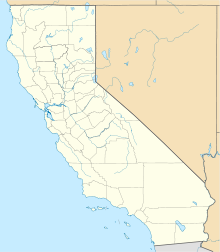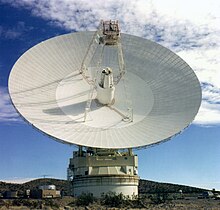Goldstone Deep Space Communications Complex
Coordinates: 35 ° 25 ′ 36 ″ N , 116 ° 53 ′ 24 ″ W.
The Goldstone Deep Space Communications Complex (GDSCC), also known as the Goldstone Observatory , is an antenna system in the Mojave Desert in southern California , USA , 60 kilometers north of Barstow .
The antenna system is part of the Deep Space Network (DSN), a global network of radio antennas operated by the Jet Propulsion Laboratory for NASA for communication with space probes and satellites as well as for radio and radar astronomical research purposes. Two other facilities are the Madrid Deep Space Communications Complex in Spain and the Canberra Deep Space Communication Complex in Australia .
history
The Goldstone Deep Space Communications Complex was founded in 1958 and covers 132 square kilometers of the Fort Irwin military restricted area. The location was chosen because it is far away from disturbing power lines, traffic, radio and television stations. The name Goldstone comes from an abandoned gold mine that was there. The complex has its own road network, a runway, its own power supply with diesel generators and a microwave communication network for the transmission of data between the antennas and the control center. There is a visitor center and training facilities. The facility can be visited on guided tours.
The largest parabolic antenna in Goldstone DSS 14 was put into operation in 1966 and was the first 64-meter antenna of the DSN. Its parabolic mirror was enlarged from 64 to 70 meters in diameter in the late 1980s in order to ensure better reception of the data from the Voyager 2 space probe during its passage through the outermost planet Neptune . In the early 1990s, the Goldstone Observatory was also used for the SETI search program . At the end of 2010 the system resumed regular operation after extensive modernization work, in which the 3200 tonne antenna also had to be lifted. DSS14 has very powerful transmitters and can be used to measure distances using radar and to create radar images of asteroids.
The three DSN complexes each have one 70 m and three 34 m antennas. If antennas are temporarily not needed for communication with spaceships, they can be used for radio astronomy. The antennas can be connected in parallel to enable higher data rates or better signal quality. A parallel connection of DSS 24, 25 and 26 has the same functionality as a 70 meter antenna. The antennas are named after the first space mission or field of application they participated in and are numbered in the order in which they were commissioned. Pioneer (DSS 11) was the complex's first antenna and was decommissioned in 1981. It was granted National Historic Landmark status by the Home Office on March 3, 1985 and is known as the Pioneer Deep Space Station .
| Inactive antennas of the Goldstone Deep Space Communications Complex | ||||||
|---|---|---|---|---|---|---|
| Surname | diameter | Activated | Disabled | Up | Down | description |
| DSS 11 - "Pioneer" | 26 m | 1958 | 1981 | National monument | ||
| DSS 12 - "Echo" | 26 m
34 m (26 m) |
1960
1961 |
1961
2012 |
The first 26 m antenna was moved in 1961 and to DSS 13 - "Venus".
In 1961 a second 26 m antenna was added, in 1979 it was extended to 34 m. 1996 rededicated by the DSN for training purposes. 2012 deactivated. |
||
| DSS 13 - "Venus" | 26 m
34 m |
1962
1991 |
1991 |
The original DSS-12 antenna was the first to capture Venus with radar waves. The 26 m antenna was replaced by a 34 m antenna in 1991. Today the system is reserved for research and development of powerful transmitters and highly sensitive receivers. | ||
| DSS 15 - "Uranus" | 34 m | 1984 | 2018 | S, X | S, X | One HEF antenna, deactivated May 2018. |
| DSS 16 - "Apollo" | 26 m | 1966 | approx. 2019 | The antenna was in the "extended downtime" status for a long time, dismantled in 2019 at the latest. | ||
| DSS 27, 28 - "Gemini" | 34 m | 1994 | deactivated | Double system (Gemini = twins) of two 34 m antennas, originally built for military use, handed over to civilian use in 1994. DSS 27 is now out of service and DSS 28 has been handed over to the Goldstone Apple Valley Radio Telescope GAVRT for training purposes. | ||
| Antennas of the Goldstone Deep Space Communications Complex | ||||||
|---|---|---|---|---|---|---|
| Surname | diameter | Activated | Disabled | Up | Down | description |
| DSS 14 - "Mars" | 70 m (64 m) | 1966 | S, X | L, S, X, Ku | In 1988 it was expanded to 70 m to support Voyager 2 as it flies past Neptune. Modernized in 2010. 20 kW transmitter for S and X band. The antenna also has an X-band radar transmitter (Goldstone Solar System Radar, GSSR). Ku-band (22 GHz) receiver for radio astronomy. | |
| DSS 23 | 34 m | planned for Sept. 2024 | 80 kW transmitter planned. The antenna will be built at the location of the "Apollo" antenna. The foundation stone was laid on February 11, 2020. The antenna should also contain a mirror and serve as a receiver for laser communication. Laser technology can achieve data rates 10 times higher than with radio waves. Due to the climatic conditions in the desert, it is expected that the system can work as a laser receiver 60% of the time. The laser communication is to be tested for the first time as part of the psyche mission. | |||
| DSS 24, 25, 26 - "Apollo" | 34 m | 1992-1996 | The Beam Wave Guide Cluster: Three 34 m antennas. A system of reflectors guides the waves into the substructure, where various receivers can be cooled and protected from the weather. | |||
| DSS 24 | 34 m | S, X | S, X, Ka | |||
| DSS 25 | 34 m | X, Ka | X, Ka | |||
| DSS 26 | 34 m | X, | X, Ka | New 80 kW transmitter since 2015 | ||
See also
Web links
- Goldstone Deep Space Communications Complex, Overview. Retrieved November 11, 2017 .
- Bill Wood: The Goldstone Deep Space Communications Complex (English)
- NASA / JPL: More pictures from GDSCC (English)
Individual evidence
- ↑ a b Goldstone DSN booklet. Retrieved May 6, 2017 .
- ↑ History | Goldstone Deep Space Communications Complex. Retrieved May 6, 2017 (American English).
- ↑ MJ Klein, S. Gulkis et al. a .: Status of the NASA SETI Sky Survey microwave observing project. In: Acta Astronautica. 26, 1992, p. 177, doi: 10.1016 / 0094-5765 (92) 90092-W ; A signal detection strategy for the SETI All Sky Survey [email protected], accessed July 23, 2010
- ↑ Flight Review January 2011, p. 76, Goldstone is fit again
- ↑ Listing of National Historic Landmarks by State: California. National Park Service , accessed July 30, 2019.
- ↑ California Institute of Technology: Deep Space Network Services Catalog 2015. pp. 3–2, 3–6 and 5–2. Archive link ( Memento of the original from December 22nd, 2016 in the Internet Archive ) Info: The archive link was inserted automatically and has not yet been checked. Please check the original and archive link according to the instructions and then remove this notice.
- ↑ Echo Station. (No longer available online.) Archived from the original on February 21, 2017 ; accessed on May 6, 2017 . Info: The archive link was inserted automatically and has not yet been checked. Please check the original and archive link according to the instructions and then remove this notice.
- ↑ Venus Station. (No longer available online.) Archived from the original on February 21, 2017 ; accessed on May 6, 2017 . Info: The archive link was inserted automatically and has not yet been checked. Please check the original and archive link according to the instructions and then remove this notice.
- ^ Antennas - Goldstone Deep Space Communications Complex. Retrieved April 27, 2019 (American English).
- ↑ California Institute of Technology: Deep Space Network Services Catalog 2015. pp. 3–2, 3–6 and 5–2. Archive link ( Memento of the original from December 22nd, 2016 in the Internet Archive ) Info: The archive link was inserted automatically and has not yet been checked. Please check the original and archive link according to the instructions and then remove this notice.
- ↑ a b NASA (ed.): Mission Introduction to the DSN . March 3, 2015 ( nasa.gov [PDF]).
- ↑ NASA Prepares for Moon and Mars With New Addition to Its Deep Space Network. Retrieved April 16, 2020 .

